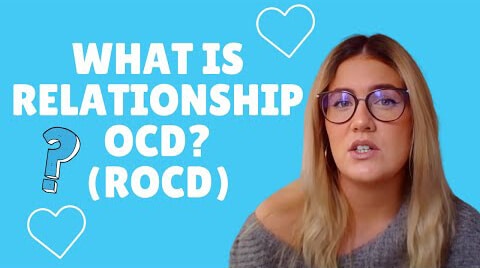
What is OCD?
Obsessive Compulsive Disorder (OCD) is a type of anxiety disorder that features unwanted thoughts (obsessions) which can cause stress and lead to the performance of repetitive behaviours (compulsions) aimed at easing this anxiety. While compulsions can lead to short-term reductions in anxiety, many people with OCD report that both their obsessions and compulsions cause significant distress and often interfere with daily life. Although people with OCD are often aware their behaviours are maladaptive or don’t make sense, many are unable to consciously change them without help from a trained psychologist.
It is thought between 1 and 2 people out of every 100 experience OCD each year, meaning OCD is a commonly experienced psychological disorder. However, due to frequent inaccurate media representation, OCD is often misunderstood or oversimplified as the desire for cleanliness/order, which can cause confusion and a lack of support for people experiencing OCD. This article will act as a beginner’s guide; outlining the causes, symptoms and treatments of OCD, thus highlighting how OCD is more complex than many think.
What causes OCD?
There is no one single cause of OCD. Like many other disorders, there can be multiple risk factors involved which vary between individuals and affect them differently. Some of the factors that make it more likely for a person to experience OCD include:
- Family History: Coming from a family with one or more OCD cases can predispose a person to developing OCD. Studies have suggested this could occur through family-shared beliefs about how responsible you are, or about how important your thoughts are (e.g. ‘I am personally responsible for ensuring others are safe).
- Biological Causes: Problems with neurotransmitters such as serotonin and norepinephrine is one biological factor suggested to predispose some individuals to OCD. There is less evidence for the prevalence of genetic factors in OCD; there may be genes which predispose people to developing disorders in general, but no specific genes for OCD have been identified.
- Critical incidents: Stresses/challenges represent the most prevalent role in the onset of OCD. Situations which generate a sense of responsibility or not being in control can be particularly strong triggers. Extensive research has shown abuse and trauma can lead to OCD onset, with compulsions serving as coping mechanisms.
Symptoms of OCD
Just as there is no single cause of Obsessive Compulsive Disorder (OCD), OCD doesn’t present the same way in all people. However, in most cases OCD symptoms can be broken down into obsessions and compulsions. Below are some of the key manifestations of OCD, in terms of these components.
Obsessions
Obsessions are repetitive and persistent thoughts, urges, or impulses that pop – unwanted and intrusive – into the mind and provoke feelings of anxiety due to their often unpleasant nature. Obsessions in OCD tend to follow common themes, the most common of which are:
- Contamination: by bodily fluids, chemicals, germs or disease. This is a typical media representation of OCD. While OCD is often portrayed in the media as excessive cleaning or hand-washing, the obsession involved is the fear of contamination for oneself or others.
- Sexual: unwanted sexual thoughts or images, sexual obsessions about children, sexual obsessions about homosexuality.
- Losing Control/Harm: worry about being responsible for something awful happening, a fear of hurting other people by not being careful enough, having an impulse to harm yourself or someone else, or an impulse to shout something obscene.
- Religion: worry about offending God, concern about morality.
- Perfectionism/Symmetry: a need to know or remember for certain, being concerned with exactness, preciseness, or orderliness. There is a lot of confusion and oversimplification surrounding this theme of OCD, to the point where OCD has become part of everyday language in regards to orderliness. Many people are particular about their belongings and way of life, but for people with OCD this need is extremely excessive and debilitating. It can even include physical injury – if a person experiencing OCD has a cut on one arm, a symmetry obsession can lead them to purposefully cut their other arm to maintain symmetry [6].
There are many other obsession themes/subthemes of OCD which cannot be fully explored in this article; click here for another lesser-known subtype of OCD. However, the common thread is that when someone with OCD has one of these obsessive thoughts, they tend to try to suppress or neutralize it with some other thought or action. These are called compulsions.
Compulsions
Compulsions are the repetitive actions, rituals or behaviours performed in response to obsessions. These compulsions are executed to relieve anxiety or to prevent a dreaded outcome. Compulsions can be external (visible things done in the outside world) or internal (things done in one’s own mind). Many people with Obsessive Compulsive Disorder (OCD) realise their actions are not rational or helpful but feel compelled to carry them out anyway. Examples of common compulsions include:
- Checking: checking that you did not harm yourself or others, checking that something terrible did not or will not happen, checking that you did not make a mistake.
- Washing and cleaning: washing hands excessively, cleaning items obsessively, excessive washing or grooming.
- Mental compulsions: praying to prevent harm, ‘cancelling’ a bad thought or word with a good one, counting and ending on a ‘right’ or ‘good’ number.
- Repeating: repeating activities, repeating body movements, repeating a mental event.
Although these compulsions can lead to short-term reductions in anxiety, in the long-term they increase preoccupation with obsessions and maintain the pattern of responses to them.
What else keeps OCD going?
This is important to consider because if we can work out what is keeping a problem going, we can treat it by intervening to interrupt this maintenance cycle. In addition to compulsions, other maintenance behaviours of OCD include:
- Avoidance behaviours: Avoiding certain situations which you think might be dangerous or induce obsessions/compulsions.
- Attention and Reasoning Biases: People experiencing Obsessive Compulsive Disorder (OCD) often also experience changes in what they pay attention to, and the kinds of conclusions they draw. For example, paying close attention to certain thoughts/situations in case they are ‘dangerous’ or could lead to an unwanted outcome. These biases become automatic over time and can actually maintain OCD due to the increased focus on negative stimuli/conclusions and decreased attention on stimuli that may disconfirm negative thoughts.
Treatment: What can be done to interrupt this maintenance cycle?
One theory of OCD focuses on the idea that it is not the intrusive thoughts themselves that lead to distress, but rather it is the meaning that people assign to them (the way thoughts are interpreted) that leads to such negative consequences as OCD. For example, a person with OCD may interpret their intrusive thoughts to mean they are a bad person or that something bad will happen and they are personally responsible for this. Once particular thoughts are interpreted as personally significant, this increases the likelihood of performing certain behaviours to keep yourself or others safe. OCD responds well to psychological treatments including cognitive behavioural therapy (CBT) and exposure and response prevention (ERP) as they address the obsession interpretations, compulsions and maintenance behaviours. The UK National Institute of Health and Care Excellence guideline for OCD recommends a mixture of both CBT and ERP for treating OCD, with a minimum of 10 therapist hours and treatment sessions increasing depending on OCD severity.
Cognitive Behavioural Therapy for OCD
CBT involves the therapist and client working together to first identify and address the client’s interpretation of their intrusive thoughts. Then, the client and therapist work collaboratively to come up with an alternative interpretation of what their intrusive thoughts mean, which is more helpful and less threatening. This is the cognitive part of CBT. This alternative interpretation is then tested in the behavioural part of CBT, which involves a process of information-gathering including symptom monitoring, behavioural experiments, and exposure exercises (ERP).
Exposure and Response Prevention (ERP)
While ERP is a treatment for OCD in itself, it is most effective when used as a behavioural component of CBT.
- Exposure: This is an effective psychological treatment for fears. When engaging in exposure exercises the aim is to feel some anxiety and to stay in the anxiety-evoking situation until your anxiety has lessened. Exposure is gradually used in CBT for OCD in order to test the alternative, less threatening interpretation of intrusive thoughts.
- Response prevention: Exposure for Obsessive Compulsive Disorder (OCD) incorporates response prevention to make it more effective. Performing compulsions prevents the individual from finding out if their obsessional worries are true. Resisting the urge to perform compulsions (response prevention) is thus a crucial part of testing interpretations and overcoming OCD.
Other treatments
While CBT and ERP are the most effective forms of OCD treatment, selective serotonin reuptake inhibitors (SSRIs) can be effective in treating adults with OCD, should you be looking for a more medical intervention.
If you think you could benefit from speaking to someone about any of the experiences and/or treatments outlined in this article, we offer a FREE 15-MINUTE CONSULTATION with one of our specialists to help you find the best way to move forward. You can book yours here.
About the author:
Saskia Huntley graduated from the University of Bath with a first class MSci (with Hons) in Psychology. Saskia is gaining valuable experience working as a Junior Therapist at Private Therapy Clinic and is assisted in providing the most evidence based treatments to her clients in order to help them achieve their treatment goals, with a special interest in OCD. In accordance with NICE guidelines, Saskia is trained in treatment protocols for both Cognitive Behavioural Therapy (CBT) and Exposure and Response Prevention (ERP) for OCD.
















